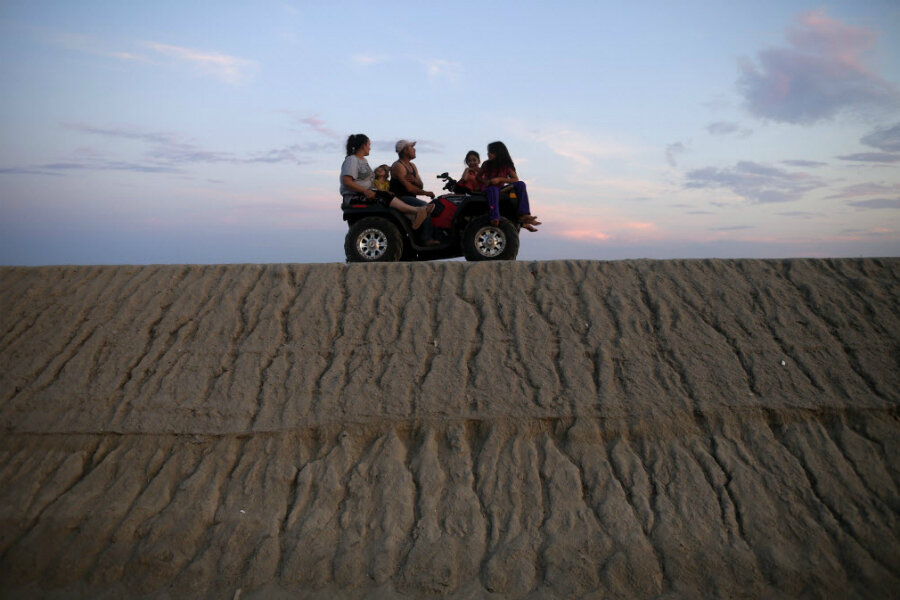Increasingly, droughts and heat waves are happening at the same time
Loading...
Across much of the United States, regional droughts and heatwaves are appearing simultaneously more frequently, imposing more-extreme conditions than either would deliver separately, according to a new study.
California's four-year drought is a case in point, says Amir AghaKouchak, a civil engineer at the University of California at Irvine and the new study's senior author.
Looking only at 2014 and using precipitation as the indicator, "it is a serious drought, but it is not that extreme," he says. It would be classed as a drought that would occur about once every 25 years. But temperatures in 2014 were well above average, he adds. Put the two extremes together and the drought becomes a once-in-200-year event.
In the past, climate scientists typically have looked at extreme conditions individually – focusing on trends in droughts or heat waves, for example. However that approach can understate the risk that global warming adds for extreme conditions, he adds.
A new, nationwide analysis of this overlap, which appears in the current issue of the Proceedings of the National Academy of Sciences, was prompted by recent studies that yielded conflicting results on global warming's impact on the length or intensity of droughts around the world.
In exploring the causes for such discrepancies, a team led by Kevin Trenberth, with the National Center for Atmospheric Research in Boulder, Colo., noted in a paper published in late 2013 that while global warming doesn't cause droughts, rising temperatures would boost the intensity of droughts and lead to quicker onset of droughts.
With rising temperatures and increases in temperature extremes, Dr. AghaKouchak and colleague Omid Mazdiyasni reasoned that heat waves and drought would overlap more frequently.
"When you have drought and heat waves happening at the same time, typically the impact is far greater" than either condition would inflict on its own, he says.
But until now, climate scientists have had a difficult time detecting such trends in a convincing way. The statistical tools they typically use to look for changes in climate conditions have a tough time showing significant trends in tandem events, AghaKouchak notes.
So he and Mr. Mazdiyasni borrowed a tool from economists' toolbox that showed promise to identify those trends in a statistically significant way.
The duo looked at drought and temperature data across the lower 48 states from 1960 to 2010. They grouped heat waves by three-, five-, and seven-day durations as well as by three levels of temperature ranges. Then they compared the drought-heat wave overlaps typical of the 20 years between 1960 and 1980 with overlaps typical of 1990 and 2010.
Most of the United States saw increases of between 20 and 80 percent in the number of concurrent droughts and heat waves and a significant increase of drought overlapping with the longest, hottest heat waves, particularly in the Southwest, the Rocky Mountain states, portions of the upper Midwest, and along the East Coast.
Indeed, the tool the team used, dubbed the Cramér–von Mises detection test, draws kudos from other climate researchers. In addition to the trends it identifies, it also identifies a point at which the trend begins to take off.
While the study doesn't try to identify a cause, the trend falls in line with what one would expect to see with global warming, say researchers who didn't take part in the work.
The analysis also suggests that for all the talk of a hiatus in global warming, the hiatus didn't apply the brakes to extreme events. The trend the new study identifies became most pronounced between 1997 and 1998. That period saw an unusually strong El Niño, which led to a then-record global average temperature. And it marked the beginning of the so-called hiatus in global warming. Yet the rise of concurrent droughts and heat waves continued.
This similar timing was a surprise, notes Richard Smith, a professor at the University of North Carolina who heads the Statistical and Applied Mathematical Sciences Institute in Research Triangle Park, N.C.
"What these authors are saying is the climate hiatus doesn't apply to extremes, if anything the opposite," adds Dr. Smith, who was not part of the research project.
The analysis identifies a statistically significant climate trend for the continental US, notes Michael Wehner, a senior scientist at the Lawrence Berkeley National Laboratory in Berkeley, Calif. The next task is to conduct the studies that pin down the reasons for it.
In the meantime, the algorithm AghaKouchak and Mazdiyasni used to find a signal of change where traditional methods did not is perhaps the study's most interesting element, Dr. Wehner says.
The study highlights the important contribution that professional statisticians have to make in describing extreme events as well as in detecting trends – a role "not being fully exploited," he adds.








